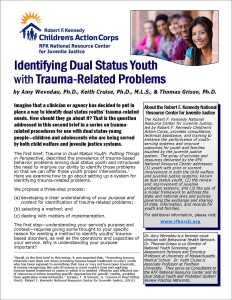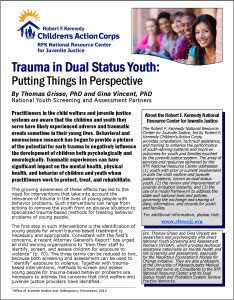Resources – Special Topics
Click here to return to the main Resources page.
 The Trajectory of a Traumatized Youth: A Three System Perspective
The Trajectory of a Traumatized Youth: A Three System Perspective
Robert F. Kennedy National Resource Center for Juvenile Justice, 2016
While many agencies are becoming trauma-informed and implementing the best practice of trauma screening, it is important to understand the entire trajectory a youth may travel into and within the systems as a result of trauma. Members of the RFK Dual Status Youth Practice Network have developed a comprehensive three-system graphic depicting the potential role trauma plays in bringing youth into the systems and moving them deeper into system involvement. Education, child welfare and juvenile justice each have a unique opportunity to interrupt this negative trajectory and create the best opportunities for successful outcomes. These graphics are meant to inform, educate and prompt discussions about the specific behaviors systems may see as a result of trauma while highlighting the individual and cross system policies and practices that can empower systems to improve outcomes for these youth.
 Identifying Dual Status Youth with Trauma-Related Problems
Identifying Dual Status Youth with Trauma-Related Problems
Amy Wevodau, Ph.D., Keith Cruise, Ph.D., M.L.S., & Thomas Grisso, Ph.D., Robert F. Kennedy National Resource Center for Juvenile Justice, 2015
Imagine that a clinician or agency has decided to put in place a way to identify dual status youths’ trauma-related needs. How should they go about it? That is the question addressed in Identifying Dual Status Youth with Trauma-Related Problems, the second brief in a series on trauma-related procedures for use with dual status young youth. The series’ inaugural brief, Trauma in Dual Status Youth: Putting Things in Perspective, described the prevalence of trauma-based behavior problems among dual status youth and introduced the need to improve our ability to identify those problems so that we can offer those youth proper interventions. This brief now examines how to go about setting up a system for identifying trauma-related problems.
 Trauma in Dual Status Youth: Putting Things In Perspective
Trauma in Dual Status Youth: Putting Things In Perspective
Thomas Grisso, PhD and Gina Vincent, PhD (University of Massachusetts Medical School), Robert F. Kennedy National Resource Center for Juvenile Justice, 2014
This article is the first in a series on trauma-related procedures for use with dual status youth—children and adolescents who come into contact with both child welfare and juvenile justice systems. It describes generally the state of our understanding of the prevalence of trauma-based behavior problems and considerations in designing agreed-upon best practices to identify them. The article also explores the importance of clearly defining one’s objectives for identifying trauma in youth, discusses the broad types of screening and assessments available for use in identification, and highlights important issues of implementation.
